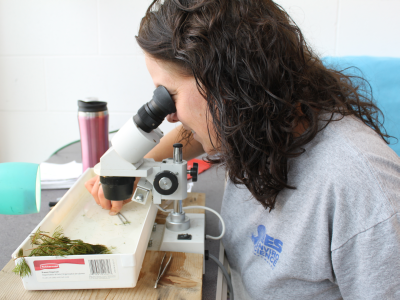After 36 years as a biologist and stewardship co-ordinator for the Ministry of Natural Resources (MNR), Bob Florean was all set for retirement last spring following his exit from the department. Then a tiny beetle changed all that.
Tapped for his experience and expertise, Florean was coaxed out of retirement after receiving a distressed call from EnviroScience, an Ohio-based ecological consulting company that specializes in ecological restoration, including the reduction of Eurasian watermilfoil, a non-Native invasive aquatic plant that is taking over Canadian lakes.
By releasing into the ecosystem thousands of milfoil weevils, a native aquatic beetle that feasts on the offending plant, EnviroScience has found a natural way to combat the spread of the plant, which is typically spread when boat owners don’t clean their boats before transferring their vessel between water bodies.
“I got a request by frustrated lake homeowners in Guelph that petitioned the company to come out, and subsequent to that, more and more information has been getting out there,” Florean said. “(EnviroScience) approached me basically to lay a path for them to enter and form a company in Ontario.”
Milfoil Solution, the Canadian arm of the company, is now based out of a lab at Collège Boréal and is helping frustrated landowners across the province combat the growing problem. Eleven Boréal students have been hired for the summer to capture the insects, cultivate the population and ready them for release.
Though he now has approvals in place from the Department of Fisheries and Oceans, the MNR and the Ministry of the Environment, Florean initially faced some resistance for bringing in an American company to help with the problem.
But a solution is needed. Florean estimates the impact of Eurasian watermilfoil and other invasive species on the Canadian economy at billions of dollars a year. Eurasian watermilfoil affects recreational use of water bodies, devalues waterfront properties by up to 20 per cent and negatively impacts Canadian fisheries.
As the plant permeates a water body, creating a dense canopy, it chokes out sunlight and oxygen, resulting in a sterile underwater environment, Florean explained. Native species die off or diminish because of a lack of nutrients and food in the water.
The plant will never be diminished entirely, but treatment with milfoil weevils can drastically reduce its prevalence, improving water quality and recreational use.
One of the affected areas is Sudbury, and the company is currently teaming up with the city and the Greater Sudbury Watershed Alliance on a three-year project to reduce the Eurasian watermilfoil in five of Sudbury’s lakes: Long, Simon, Grant, Richard and McFarlane.
In 2011, the first year of the project, Milfoil Solution released 76,000 weevils into the lakes, and this year is on target to release 45,000 more, said Kyle Borrowman, project manager with Milfoil Solution. Residents don’t have to be concerned about an overrun of the species, however, since the purpose of the project is to bolster the numbers of a species that’s already here, a process called augmentative biocontrol.
“They only feed on Eurasian watermilfoil,” Borrowman said. “They don’t bite; they don’t try to get into your homes. They’re very small, and they only go a few metres away from shoreline.”
Treatment typically takes two to three years, with a improvement to the lakes noticeable by year four, Florean added.
As a “growing threat” that’s impacting landowners right across the country, Florean sees this as a growth industry. With concerns increasing about the impact of herbicides and pesticides on water bodies, milfoil weevils offer a more natural solution, he said.
It’s also cheaper. Though it depends on the size of the lake and the level of infestation, the harvesting of Eurasian watermilfoil—which offers no guarantees since even a small slip of the plant left behind can foster new plant growth—can cost upwards of $150,000 over five years. Herbicide use can cost $110,000 over the same period. Milfoil Solution’s treatment costs only $35,000.
Florean is now waiting for approval from Parks Canada, in particular, for approval to use the application in the Trent-Severn Waterway, which is facing “huge problems” with the plant. He has also received inquiries from frustrated landowners in British Columbia.
One of his strongest testimonials came from Owen Williams, chair of the Ontario Invasive Plants Council, who describes Milfoil Solution as a “perfect example” of how native species can be used to control non-native and aggressive invasive species such as Eurasian watermilfoil.




